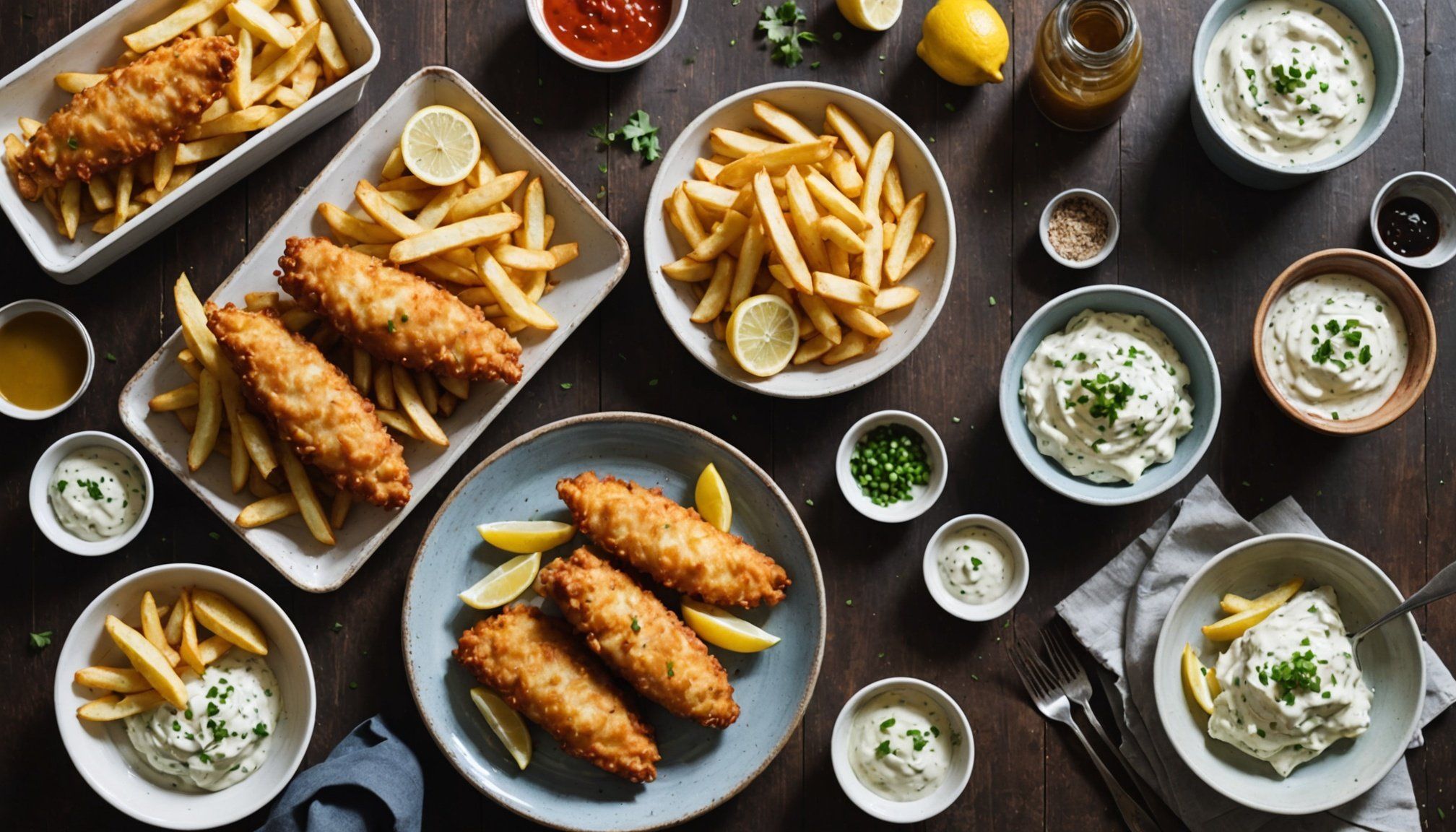Understanding Fish and Chips
Fish and chips have a rich history that firmly roots them as a classic British dish. Emerging in the mid-19th century, this humble meal paired fried fish with chips, or what some might call “fries.” The origins trace back to Jewish immigrants who introduced their technique of frying fish to the East End of London, harmonising perfectly with the staple potatoes people were consuming daily. This blend of ingredients not only enhanced the taste but also made it accessible for the working class.
As it evolved, fish and chips became more than just a meal. Today, it holds a cultural significance, symbolising traditional British culture. Its indispensability in cuisine is evident, with countless establishments dedicated to perfecting their recipes. Moreover, the dish’s influence stretches beyond Britain, celebrated in countries like Australia and New Zealand.
In parallel : Mastering the perfect english custard tart: insider tips and techniques unveiled!
Interestingly, its evolution coincides with societal changes. During wartime, fish and chips witnessed increased consumption due to their affordability and nutritional value. Recognising its cultural impact, UNESCO is considering granting the dish World Heritage status. As it continues to be a favourite, fish and chips remain a cherished symbol of British heritage.
Selecting the Right Ingredients
Choosing the perfect ingredients is essential for achieving deliciously crispy fish and chips. When it comes to fresh fish, options like cod, haddock, and pollock are popular due to their mild flavours and flaky textures. Cod offers a sweet flavour, while haddock provides a more robust taste. Pollock is another great choice, often praised for its versatility and subtle flavour.
This might interest you : Discover the art of creating the ultimate traditional british christmas pudding: a comprehensive guide
For the best chips, selecting the right type of potatoes is paramount. Varieties such as Maris Piper, King Edward, and Russet are ideal, thanks to their high starch content. This attribute helps achieve the desired crispy exterior and fluffy interior. The texture of the chips enhances the overall dish’s satisfaction and balance.
Sourcing fresh ingredients wisely ensures quality meals. Prioritising sustainable choices benefits not only your health but also the environment. Seek out locally sourced fish, supporting responsible fishing practices. Visit local markets for freshly harvested potatoes, reducing transport emissions. Understanding where your ingredients come from empowers you to make ethical and conscientious cooking decisions. By selecting high-quality, fresh options, every bite of your fish and chips promises a delightful experience. With these tips, you’ll enjoy a meal that’s both tasty and sustainably crafted.
Preparing the Fish
Mastering fish preparation involves essential steps to enhance your dish’s flavour and texture. Understanding how to effectively clean, cut, and cook will ensure your fish is fresh and delicious.
Cleaning and Cutting the Fish
Proper cleaning practices are vital for freshness and safety. Start by scaling and removing any bones or undesirable parts, ensuring the fish is free of contaminants. Carefully cut the fish into portions, maintaining uniformity for even cooking. Such meticulous attention guarantees a foundation for a delectable meal.
Crafting the Perfect Batter
The right batter recipe influences both texture and flavour. Opt for traditional beer batter for a crispy finish, or experiment with tempura for a lighter crunch. Tailoring batters with spices can enhance taste without overpowering the fish. A well-crafted batter is key to elevating the overall dining experience.
Essential Frying Techniques
The cornerstone of exquisite fried fish lies in oil temperature and frying techniques. Maintain oil heat at approximately 350°F (175°C) for optimal results. Frying time varies, but achieving a golden brown crust while ensuring the fish is cooked through is crucial. Adopting these techniques ensures a satisfying and perfectly cooked fish dish.
Making Crispy Chips
Creating crispy chips is both an art and a science. Chip cooking methods significantly influence their texture and flavour. You can choose baking or frying, each offering unique benefits. Baking is a healthier alternative, requiring less oil, whereas frying, especially double-frying, provides the ultimate crunch.
Baking vs. Frying
Baking involves cooking chips in an oven at a high temperature. This method is popular for those seeking healthier snacks, as it uses less oil. The challenge lies in achieving the same level of crispiness as frying. To enhance textures, cut potatoes uniformly, and evenly spread them on the baking tray.
Conversely, frying chips, particularly double-frying, yields exceptional crispiness. The science behind double-frying involves frying the chips initially at a lower temperature, then frying again at a higher temperature. This technique ensures that the chips’ interior softens while the exterior becomes perfectly crunchy.
Flavoring and Seasoning
After achieving the desired crispiness, seasoning tips can elevate chip flavour. Flavourings can range from classic salt to innovative spice blends. Add seasoning when the chips are hot to ensure even distribution and adhesion. Consider experimenting with different combinations, such as garlic powder or paprika, to provide a unique twist.
Crafting Irresistible Tartar Sauce
Tartar sauce is a versatile condiment that can transform any dish with its unique blend of flavours. When making homemade sauce, the choice of ingredients can dramatically influence the taste and texture of the final product.
Classic Tartar Sauce Recipe
Creating a classic tartar sauce at home is simple and rewarding. Start with a base of mayonnaise for its creamy texture. To this, add finely chopped capers and gherkins, which provide the signature tang. A squeeze of lemon juice brings a fresh zing, while a sprinkle of dill enhances the herbal notes. This ingredient combination is key to achieving the authentic flavour associated with traditional tartar sauce.
Creative Variations of Tartar Sauce
Injecting creativity into tartar sauce variations can be delightful. Consider adding a dash of hot sauce for a spicy kick or mixing in horseradish for extra bite. You might also try using yogurt as a healthier alternative to mayonnaise without sacrificing creaminess. Experimenting with herbs like parsley or tarragon can lead to exciting new flavour profiles.
Ideal Pairings with Fish and Chips
Tartar sauce complements fish and chips perfectly, enhancing the dish with its creamy and zesty elements. Pair your sauce with homemade sauce variations to elevate the meal’s enjoyment. Whether you prefer classic or inventive twists, the right tartar sauce can make your dining experience memorable.
Serving Suggestions and Pairings
Elevating your fish and chips experience can be as simple as adding thoughtful presentation. Consider serving the dish on a wooden board or a stylish plate to give it a sophisticated twist. For a touch of flair, garnish with fresh parsley or lemon wedges. A drizzle of tartar sauce in neat patterns can also make the presentation more appealing.
Recommended Side Dishes
To complement your meal, pair fish and chips with classic side dishes. Mushy peas provide a traditional and comforting addition, while a vibrant coleslaw adds crunch and freshness. Pickled onions or gherkins can introduce a tangy contrast, enhancing each bite.
Beverage Pairings
The right beverage can elevate the flavours of your dish. Crisp white wines, such as Sauvignon Blanc, are excellent choices for cutting through the richness of fried fish. For a quintessentially British twist, ale or lager complements the dish while bringing out earthy tones. Some may enjoy non-alcoholic options like sparkling water with lemon for a refreshing cleanse of the palate.
While seemingly simple, understanding these pairings ensures a balanced and delightful dining experience. Exploring the various possibilities with side dishes and beverages can truly make your fish and chips memorable.









